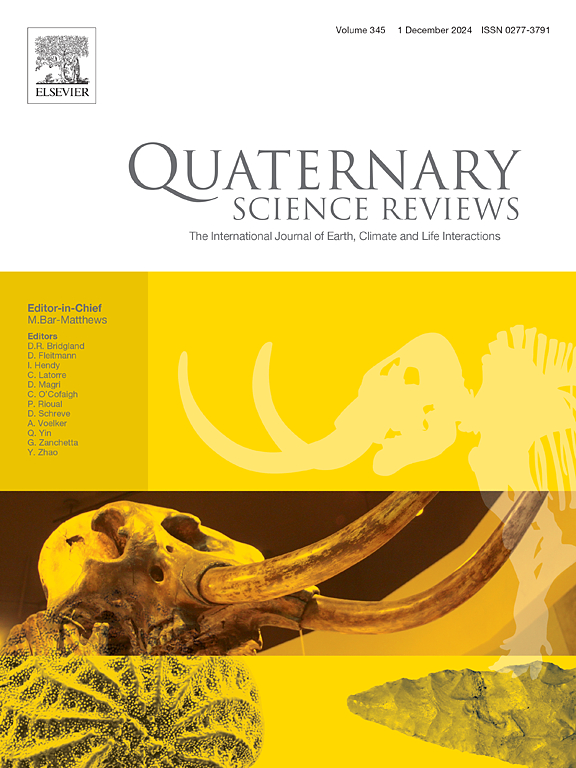A 1700-year peatland-based hydroclimate record from the Hengduan Mountains in the southeastern Tibetan Plateau reveals changing dynamics of the summer monsoon interface
IF 3.3
1区 地球科学
Q1 GEOGRAPHY, PHYSICAL
引用次数: 0
Abstract
The Indian summer monsoon (ISM) and the East Asian summer monsoon (EASM) affect precipitation patterns across the broad Asian continent. The southern Hengduan Mountains region in the southeastern Tibetan Plateau is located at the ISM–EASM interface, but how these two monsoon systems affect long-term regional precipitation variability remains unclear. Here, we develop a 1700-year record of centennial-scale hydroclimate variability from a rarely reported Sphagnum-dominated subalpine peatland in the southern Hengduan Mountains, using Sphagnum-specific cellulose δ13C and δ18O proxies that are supported by characterization of modern proxy–environment relationships.
Based on the modern variability of cellulose δ13C and δ18O in Sphagnum growth increments, we show that δ13C is a reliable proxy for moisture availability, following the “water film” mechanism. In contrast, δ18O is controlled by multiple mechanisms and can increase due to either higher precipitation δ18O and stronger evaporative enrichment under drier conditions or increased plant use of evaporated pool water caused by pool expansion under wetter conditions. Using the time-varying δ13C–δ18O correlation as a constraint, we infer from our coupled cellulose δ13C–δ18O records several centennial-scale moisture shifts, including wet shifts during 700–1200 CE, 1500–1800 CE, and after 1950 CE, and dry shifts during 300–700 CE, 1200–1500 CE, and 1800–1950 CE, with a generally wetter Medieval Warm Period than the Little Ice Age. The temporal pattern is consistent with previously published regional pollen-climate records but shows disparities from those lake-based terrestrial input records. Based on our novel single-stem isotope analysis, we hypothesize that the latter might be additionally affected by changes in extreme event characteristics.
We find that our new hydroclimate record shows an in-phase relationship with ISM records in the Indian subcontinent, except during 1500–1800 CE and in recent decades, during which our analysis presents evidence for an increased influence from EASM system. We attribute the transitions in large-scale hydroclimate patterns during these two periods to La Niña mean-state and anthropogenic radiative forcing, respectively, which weaken zonal wind flows over the Bay of Bengal—the key passage of the ISM. This study highlights the non-stationary relationship between hydroclimate and Asian summer monsoon dynamics at the ISM–EASM interface.
青藏高原东南部横断山区1700年泥炭地水文气候记录揭示了夏季风界面的变化动态
印度夏季风(ISM)和东亚夏季风(EASM)影响整个亚洲大陆的降水模式。青藏高原东南部横断山南区位于ISM-EASM界面,但这两个季风系统如何影响区域长期降水变率尚不清楚。本文利用sphagum特有的纤维素δ13C和δ18O代用指标,在现代代用-环境关系表征的支持下,建立了横断山南缘sphagum主导的亚高山泥炭地1700年的百年尺度水文气候变化记录。基于Sphagnum生长增量中纤维素δ13C和δ18O的现代变化,我们表明δ13C是水分有效性的可靠代表,遵循“水膜”机制。相比之下,δ18O受多种机制控制,在干燥条件下,降水δ18O的增加可能是由于降水δ18O的增加和更强的蒸发富集,或者在潮湿条件下,由于水池膨胀导致蒸发池水的植物利用增加。利用随时间变化的δ13C -δ18O相关性作为约束,我们从耦合的纤维素δ13C -δ18O记录中推断出几个百年尺度的水分变化,包括700-1200 CE、1500-1800 CE和1950 CE之后的湿移,以及300-700 CE、1200-1500 CE和1800-1950 CE的干移,其中中世纪暖期比小冰期普遍湿润。时间格局与先前发表的区域花粉气候记录一致,但与基于湖泊的陆地输入记录存在差异。基于我们新颖的单茎同位素分析,我们假设后者可能受到极端事件特征变化的额外影响。除了1500-1800年和近几十年,我们发现新的水文气候记录与印度次大陆的ISM记录呈同相关系,在此期间,我们的分析显示EASM系统的影响增加。我们将这两个时期大尺度水文气候模式的转变分别归因于La Niña平均状态和人为辐射强迫,它们减弱了孟加拉湾(ISM的关键通道)上空的纬向风流。本研究强调了在ISM-EASM界面上水文气候与亚洲夏季风动力学的非平稳关系。
本文章由计算机程序翻译,如有差异,请以英文原文为准。
求助全文
约1分钟内获得全文
求助全文
来源期刊

Quaternary Science Reviews
地学-地球科学综合
CiteScore
7.50
自引率
15.00%
发文量
388
审稿时长
3 months
期刊介绍:
Quaternary Science Reviews caters for all aspects of Quaternary science, and includes, for example, geology, geomorphology, geography, archaeology, soil science, palaeobotany, palaeontology, palaeoclimatology and the full range of applicable dating methods. The dividing line between what constitutes the review paper and one which contains new original data is not easy to establish, so QSR also publishes papers with new data especially if these perform a review function. All the Quaternary sciences are changing rapidly and subject to re-evaluation as the pace of discovery quickens; thus the diverse but comprehensive role of Quaternary Science Reviews keeps readers abreast of the wider issues relating to new developments in the field.
 求助内容:
求助内容: 应助结果提醒方式:
应助结果提醒方式:


